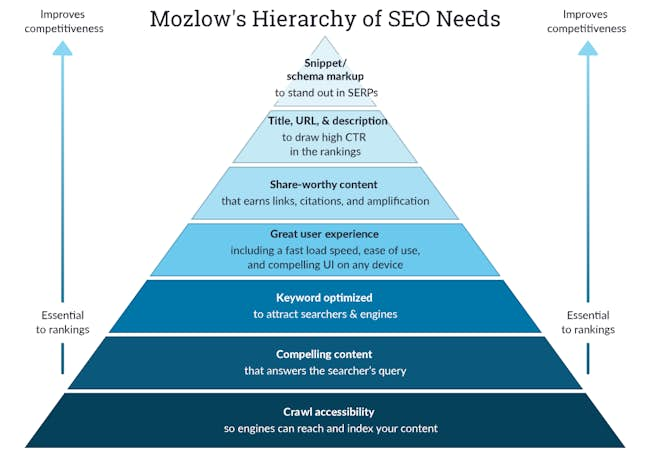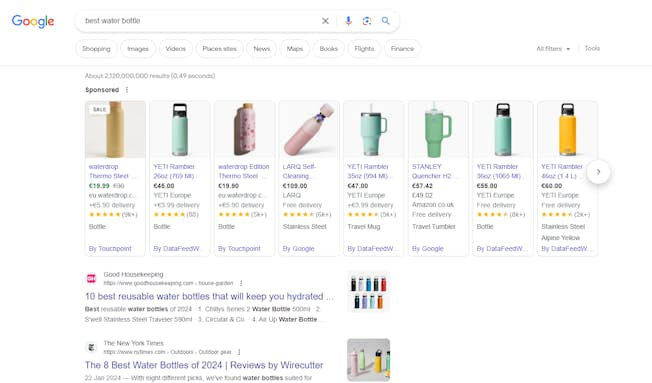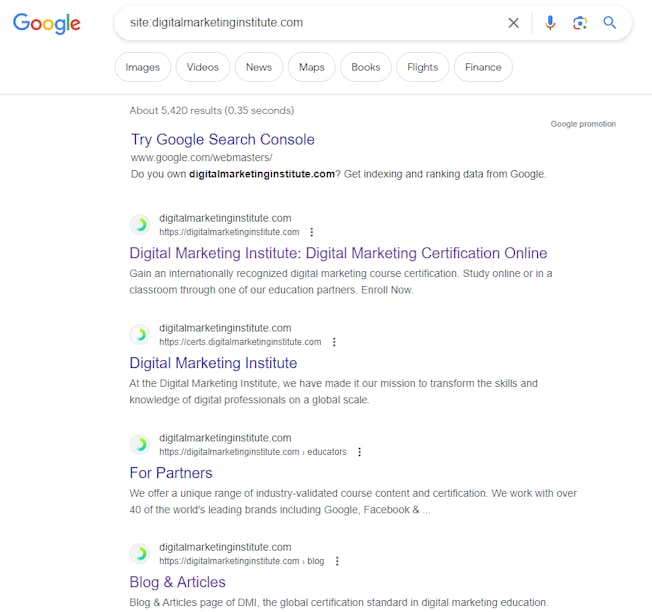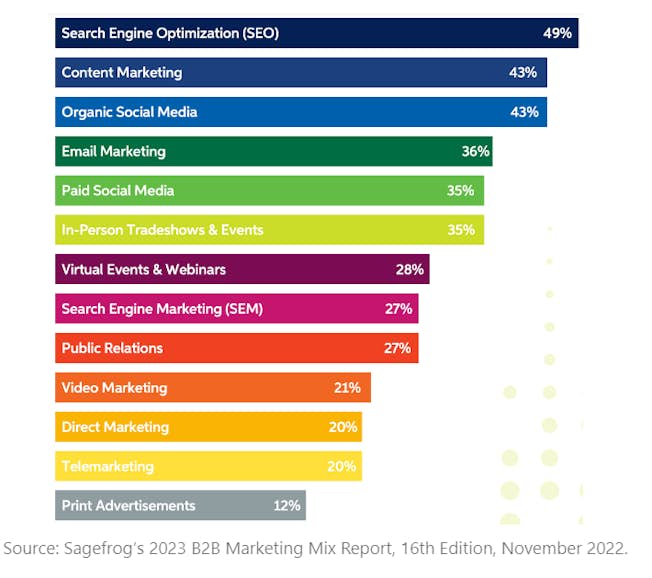Are you at the start of your Search Engine Optimization (SEO) journey? Maybe you’ve heard that SEO can help drive traffic to your website and get you higher rankings on search engines.
We’re here to remove any confusion or complications around SEO - with some insight on how artificial intelligence fits into the picture. Once you understand the fundamentals, you can learn how to leverage SEO to drive traffic and generate quality leads.
12 Ways Digital Marketers Can Use ChatGPT
So, let’s get started to see how SEO works. What you’ll learn in this blog is:
- What is SEO?
- What are the three pillars of SEO?
- Paid search vs. organic search - the differences and similarities
- How do search engines work?
- How does Google order and rank search results (and how to optimize for RankBrain)?
- What is an SEO strategy?
- How to set objectives for your SEO strategy
- 3 examples of SEO objectives
- How to set objectives for different business types
- How to become an SEO specialist
- What skills do you need to become an SEO specialist?
- What can you earn as an SEO specialist?
- AI and SEO - what’s coming?
What is Search Engine Optimization (SEO)?
Let’s start by asking an obvious question: what exactly is SEO?
SEO stands for ‘Search Engine Optimization’, which is the process of getting traffic from free, organic, editorial, or natural search results in search engines. It aims to improve your website’s position in search results pages (SERPs). Remember, the higher the website is listed, the more people will see it.
There’s a great graphic created by Rand Fiskin, co-founder of Moz, that takes from Maslow's Hierarchy of Needs’ pyramid. Fishkin’s ‘Mozlow's Hierarchy of SEO Needs’ looks at how people should execute SEO.

Top tip: SEO is no longer confined to search engines like Google or Bing. It’s also important for social networks such as YouTube and TikTok as people turn to social media to find information.
What are the three pillars of SEO?
As a digital marketer, knowing how to get your brand, website, or company found by searchers is a core skill, and understanding how SEO is evolving will keep you at the top of your game.
While SEO changes frequently in small ways, its key principles do not. We can break SEO into three core components or pillars that you need to be familiar with – and action regularly:
Technical Optimization: Technical Optimization is the process of completing activities on your site that are designed to improve SEO but are not related to content. It often happens behind the scenes. A simple example of technical optimization is submitting your sitemap to Google.
On-Page Optimization: On-Page Optimization is the process of ensuring the content on your site is relevant and provides a great user experience. It includes targeting the right keywords within your content and can be done through a content management system like WordPress, Wix, Drupal, Joomla, Magento, or Shopify.
Off-Page Optimization: Off-Page Optimization is the process of enhancing your site’s search engine rankings through activities outside of the site. This is largely driven by high-quality backlinks, which help to build the site’s reputation.
Paid search vs. organic search - the differences and similarities
From the outset, it’s important that you understand the differences and similarities between the organic, natural search synonymous with SEO and paid search.
What are the differences between paid and organic search?
There are five key differences between paid and organic search. Let’s look at each one of them.
Position
The first difference is that paid search results appear at the top of search engine results pages, and organic results appear beneath them.
Here’s an example from searching ‘best water bottle’. The paid ads or sponsored posts come up as images while the organic results are below it.

Be aware that the arrival of Google Search Generative Experience (SGE) is changing display advertising all the time using AI. So it’s important to keep on top of developments for your SEO activities.
Time
Another key difference between paid and organic search is time. With paid search, you can get results quickly whereas, with organic search, results take more time - often weeks, months, and even years. So you have to play the medium to long-term game with organic search.
Payment
As the name suggests, you pay for paid search traffic, with pay-per-click (PPC) on a cost-per-click (CPC) basis.
What that means is, you pay a fee every time a user clicks on your ad. So instead of relying on organic traffic to your website, you buy traffic for your page by paying Google to show your ad when your visitor searches for your keyword.
For organic search, traffic is free, although it does require an investment of both resources and time.
ROI
In terms of the return on investment (ROI), it's much easier to measure paid search. That's partly because Google provides more keyword data that you can capture in Google Analytics (GA4).
However, with paid search, ROI can stagnate or decline over time. With organic search, ROI is a little bit harder to measure, but it often improves over time. Over the long term, organic search can offer a very good return on investment.
Share of traffic
When it comes to traffic share, research from BrightEdge found that organic search is responsible for 53% of all site traffic compared to paid at 15%. So the lion’s share of clicks are actually on the organic results.
It’s not all about differences – there are also similarities between paid and organic search:
Keyword research: You use a search engine for both paid and organic search, and both require a user to enter a keyword. So you need to do keyword research for organic search and paid search.
Landing pages: Both types of search require you to create great landing pages. For SEO, the landing page needs to be connected to your website. For paid search, it can be the exact same landing page you use for organic, or it can be a completely separate stand-alone page that sits on your website.
Traffic: Generating traffic is a major goal of both paid and organic search. Most importantly, both paid and organic search traffic include user intent. That is, someone is asking Google a question or searching for information – they are in an active mindset and as a result they are more likely to take action once they find this information.
How do search engines actually work?
Search engines are used by people when they have a query and are searching online for the answer.
Search engine algorithms are computer programmes that look for clues to give searchers the exact results they are looking for. Search engines rely on algorithms to find web pages and decide which ones to rank for any given keyword. Remember there’s also social media algorithms to consider for search.
There are three steps to how search engines work: crawling, indexing and ranking.
Step 1: Search Engine Crawling
The first step is crawling. Search engines send out web crawlers to find new pages and record information about them. We sometimes call these web crawlers ‘spiders’,‘robots’ or Googlebots.
Their purpose is to discover new web pages that exist, and to periodically check the content on pages they’ve previously visited to see whether they've changed or been updated.
Search engines crawl web pages by following links they’ve already discovered. So if you have a blog and it's linked from your homepage, when a search engine crawls your homepage, it will then look for another link and may follow the link to your new blog post.
Step 2: Search Engine Indexing
The second step is indexing. Indexing is when a search engine decides whether or not it is going to use the content that it has crawled. If a crawled web page is deemed worthy by a search engine, it will be added to its index.
This index is used at the final ranking stage. When a web page or piece of content is indexed, it is filed and stored in a database where it can later be retrieved. Most web pages that offer unique and valuable content are placed into the index. A web page might not be placed in the index if:
- The content is considered duplicate
- The content is considered low value or spammy
- It couldn’t be crawled
- The page or domain lacked inbound links
Top tip: You can check your indexed pages by typing ‘site:yourdomain.com’ in the search bar (see our example below). This will show you the pages showing up on Google. For a more detailed report you can look at the ‘Index Coverage report’ in Google Search Console.

Step 3: Search Engine Ranking
The third step is really the most important, and that is ranking. Ranking can only happen after the crawling and indexing steps are complete. So once a search engine has crawled and indexed your site, your site can be ranked.
There are more than 200 ranking signals that search engines use to sort and rank content, and they all fit under the three pillars of SEO: technical optimization, on-page optimization, and off-page optimization.
Some examples of signals that search engines use to rank web pages are:
- Keyword in title tag – Whether the keyword or a synonym was mentioned on the page and within the title tag
- Loading speed – Whether the web page loads quickly and is mobile-friendly
- Website reputation – Whether the web page and website is considered reputable for the topic being searched for
- Backlinks - the quantity and quality of backlinks to a web page
- Content quality and relevance - Is the content valuable and relevant to the website’s target audience?
- Mobile friendliness - Are pages, content and images optimized for mobile?
If you're looking for agency support in the areas of SEO, content marketing and paid media, get in touch with Neil Patel Digital
How does Google order and rank search results?
Google has a collection of algorithms such as Hummingbird, Panda and RankBrain that are responsible for deciding how to order and rank search engine results.
The machine-learning based algorithm RankBrain builds off Hummingbird and works by:
- If RankBrain sees a word or phrase it isn’t familiar with, it uses artificial intelligence to understand it better by connecting it to similar search queries through word vectors - in other words, understand ‘search intent’.
- It allows Google to understand these queries by converting keywords into known topics and concepts, meaning it can provide better search engine results – even when queries are unusual.
- Rather than attempting to be the best keyword optimized result, RankBrain rewards websites that provide user satisfaction (by measuring it) and return the result that the user expects.
For ranking, you should also consider Google’s EEAT (Experience, Expertise, Authoritativeness, and Trustworthiness) framework which may not be a ranking factor but it’s a component of its Search Quality Evaluator Guidelines.
Top tip: Other technologies to consider are Google Multitask Unified Model (MUM) and the AI-chatbot Google Bard (now called Gemini).
How to get the most out of RankBrain
A good SEO strategy is to optimize your website to improve user experience and satisfaction, and try to get the most out of the RankBrain ranking factor.
The most effective ways to do this are:
- Optimize for long-tail and medium-tail keywords (phrases and key terms consisting of two to three words).
- Use natural language to write the way people speak as it’s more likely to be understood and ranked. The content should also be relevant and valuable.
- Optimize page titles and descriptions so that when someone searches, your listing is more likely to be clicked. The click-through rate is the percentage of people who see you on Google and then go ahead and click through to your website.
- Optimize content to increase dwell time (the length of time people stay on the page) and reduce bounce rate (the percentage of visitors who leave after only viewing one page).
- Improve interactions to show engagement and increase dwell time on the page. You could do this by adding videos, breaking up text with images or including expert quotes or tips.
What is an SEO strategy?
Like anything in digital marketing, you need a strategy to help implement, track and tweak to be successful. It’s the same for your SEO.
An SEO strategy is focused on optimizing your content to get ranked as high as possible on search engines - preferably page or position #1. Its goal is to boost organic traffic so you get found by your target personas.
A strategy for SEO also helps you to stay on track with your content. Instead of investing time and money into content that won’t perform, you will create quality content based on performance and user intent.
Top tip: If you’re a small business or one operating in a specific area, then local SEO is an important element to bake into your strategy. It will help you get found by people in your area.
How to set objectives for your SEO strategy
Setting SEO objectives is a vital part of any SEO strategy. It is important to set SEO objectives – and align them with your overall business objectives as:
- They encourage buy-in from key stakeholders
- They help you to formulate your SEO strategy
- They ensure goals are met
What metrics should you measure for SEO?
While it can feel like a time-consuming task to set objectives, measuring them can help you make progress with your SEO in the long term. So what metrics should you measure to track performance?
- Keywords
- Organic traffic
- SERP results
- Time spent on page
- Engagement rate
- Click-through rate
- Brand awareness
- Leads and revenue
- Domain authority
3 Examples of SEO objectives
When setting objectives and KPIs it’s important to be realistic. If you’re starting from nothing - i.e. you’re only starting to use SEO properly - then be modest in your figures but also have ambition.
If you have already been using SEO and seeing results, be more aggressive with your targets but base them on existing data. Setting unrealistic percentages will only bring disappointment.
Here are three examples of SEO objectives that can be used as a guide to setting relevant objectives for your own business or website:
- Move 50% of our top 20 keywords onto the first page of Google within nine months This objective focuses on keyword ranking.
- Improve our year-on-year organic traffic by 20% in quarter three and 25% in quarter four - This objective focuses on increasing organic website traffic.
- Grow our SEO market share from 3% to 5% in the next financial year - This objective focuses on growing market share.
How to set objectives for different types of businesses
The focus of your objectives will vary depending on whether your business is transactional or informational.
If your business is transactional and you have an e-commerce element, you’ll want to set your objectives around tracking sales and lead conversions. However, if you're a non-ecommerce commercial site, you’ll want to focus on lead generation.
If your business is informational, you are more likely to set objectives focusing on brand awareness or website traffic.
Remember, even when you have fully implemented your SEO strategy, SEO is never finished. With SEO, you may need to change tactics midway through, play a long game, and wait to see the end results. But with a solid SEO foundation in place – and a little patience – the benefits of your SEO strategy should become apparent, leading to a better user experience for customers and more conversions for your business.
How to Become an SEO Specialist
Now that you know what SEO is and how to use it, would you like a career in the area? If the answer is yes, then you’re in luck. Not only is it a skill that’s in high demand by companies across industries but you can also make a healthy living from it.
Sagefrog's recent report found that SEO is a top marketing tactic, with nearly half of B2B companies using it in their marketing strategy, while companies plan to allocate 31% of their budgets to SEO in the coming year.

What skills do you need to become an SEO specialist?
Companies rely on organic traffic to increase online visibility and when it works, they enjoy the rewards of SEO as a low-cost strategy.
There are a number of skills you need to succeed in the area of SEO.
- Keyword research
- Link building strategy
- Content optimization
- Data analysis
- Content marketing or copywriting
- Technical SEO
As well as these hard, or technical skills, you also need to consider your ‘soft skills’, such as critical thinking, communication, and teamwork.
What can you earn as an SEO specialist?
The salary of an SEO expert can depend on where they work: freelance, agency, or in-house. It will also depend on the level of experience and time spent doing SEO effectively.
According to Search Engine Land, you can earn:
- Entry level - $49k to $72k per year
- SEO analyst/SEO executive - $62 - $101k per year
- SEO strategist - $69k - $110k per year
- SEO manager - $80k - $120k per year
- Head of SEO - $109 - $192k per year
Key resources:
The Ultimate Guide to Becoming an SEO Expert - SEMRush
Search Marketing Interview Preparation Toolkit - DMI
What Does an SEO Manager Do? - DMI
What are the best SEO tools?
Luckily, there are loads of great resources and tools out there to help with your SEO activities. Some have free plans and others are paid, so it’s about finding what’s best for you.
Ranking and reporting SEO tools
- Google Search Console
- GA4
- KWFinder
- SemRush
Page Speed Insights
SEO audit tools
- Screaming Frog
- SEOptimer
- Moz
SEO keyword and content research tools
- Google Keyword Planner
- Answerthepublic
- UberSuggest
- BuzzSumo
SEO AI tools
- seoClarity
- Surfer
AI and SEO - what’s coming?
Artificial intelligence is already used to optimize many areas of SEO. From using tools to help with keyword research and content generation to getting AI-driven insights and user intent intel.
Developments to monitor in AI and SEO are:
- Google’s Search Generative Experience (SGE) - Featured snippets on steroids, SGE uses AI to generate detailed results to give users exactly what they are searching for. This includes not only a detailed generative answer (similar toChatGPT) but also offers an image carousel along with suggested questions and suggestions. It’s important to keep an eye on how SGE becomes a greater element within the world of search.
- Predictive analytics - You can predict changes in search algorithms and adapt your strategy accordingly. Use AI tools that examine historical data and current trends to make predictions such as RankSense, Ahrefs, and CognitiveSEO.
- AI in local SEO - Optimize content to localize content based on preferences or regional factors. Tools that can help are Moz Local, and BrightSpark.
- Answer Engine Optimization - AI is changing how users search and find information so it could be a good idea to optimize for answer engines. Tools that can help are ChatGPT and Google SGE.
- Video SEO - People love video content so it’s crucial to optimize your videos for SEO, on YouTube or otherwise.
- Core Web Vitals (CWV) - The CWV consists of three user experience metrics that measure the loading, interactivity, and visual stability of a web page. Optimizing them will improve the page speed and SEO ranking.
Use SEO to drive traffic and boost brand awareness
SEO done well can reap huge rewards for marketers and businesses. Our Professional Diploma in Search Marketing with Neil Patel will help you understand search fundamentals and explore key areas like optimizing SEO, paid search campaigns, search strategy, search analytics, demand generation and much more. Reserve your place today!
Related
Upgrade to Power Membership to continue
your access to thousands of articles, toolkits, podcasts, lessons and much much more.
Become a Power Member- Login
- View Courses
- - - -
- Courses
- Resources
- - - -
- My Account
- Change Password
- Logout






